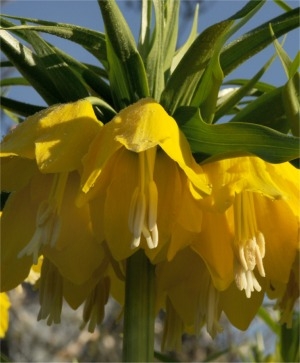 Fritillaria Horticultural Tips
Fritillaria Horticultural Tips
Deer- and rodent-resistant Fritillaria have ivory, yellow, green, plum or two-tone pendant, bell-shaped flowers on lithe wiry stems, or strong upright racemes. The degree of compaction between the pendant florets varies by variety. Varieties of Fritillaria persica have variable compaction of florets on their upright racemes. Available in diverse heights ranging from 8" to 36" tall and sizes, most of our Fritillaria were native to the western Himalayas and Asia Minor as far back as 1575. They prefer rich, well-draining neutral pH soil and filtered sunlight. A bit more finicky than other flower bulbs, these heirlooms don't like being out of the soil, so plant them immediately upon receipt.
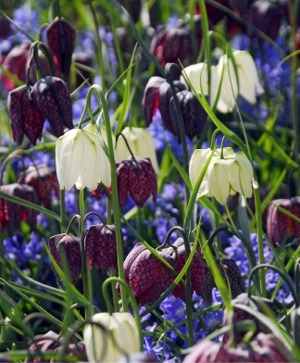 Heirloom Fritillaria
Heirloom Fritillaria
If you are looking for heirloom flower bulbs, you’ve hit the jackpot with Fritillaria.
1874 Fritillaria acmopetala
1590 Fritillaria imperialis Maxima Lutea
1590 Fritillaria imperialis Rubra Maxima
1575 Fritillaria meleagris
1575 Fritillaria meleagris Alba
1905 Fritillaria michailovskyi
1857 Fritillaria pallidiflora
1585 Fritillaria persica
1874 Fritillaria uva-vulpis
Horticultural Zone Hardiness
Each variety of Fritillaria has its own hardiness zone requirements that should be considered when selecting varieties for your garden. If your garden is in a horticultural zone that is either too cold or only marginally appropriate, you may want to apply no more than a 2" layer of mulch after the ground surface freezes in the fall. The mulch should trap the cool temperatures into the soil, not warmth. Mulch helps to protect the bulbs from arctic temperature spikes. Good mulching mediums include straw, salt marsh hay or oak leaves. In the spring, you can loosen the mulch in the area in which the Fritillaria will be sprouting.
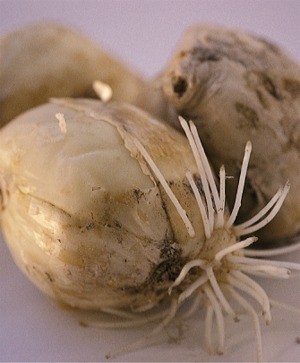 Bulb Inspection
Bulb Inspection
Check your shipment against the packing slip and make sure that everything is as it should be. Occasionally, bags of smaller bulbs may be placed in the inner boxes of other bulbs to reduce jostling during shipment. If you can’t find something, open all of the inner boxes. If there is a discrepancy, please call us immediately so that we may resolve it with you. Since every bag or box of bulbs in your order has been scanned using its UPC barcode, we can usually tell you in which box each variety is located.
Inspect your bulbs carefully. We make every effort to ship you only healthy, firm, top quality bulbs.
Fritillaria bulbs look different from other types of flower bulbs like Tulips or Narcissi. It is natural for some types of bulbs to develop a transportation mold when they are exposed to oxygen. It is a natural gray-blue-green mold that occurs when they are exposed to air, and that disappears as soon as the bulbs are planted. The soil naturally wicks it away. If you prefer, you may spread the bulbs out in the sun, or brush it off with a paper towel although it is not necessary.
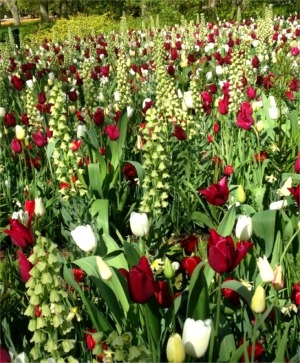 Little cuts, scars, discolored exteriors and dimples are normal marks from the flower bulb harvesting, cleaning and sizing processes in the Netherlands. Some bulbs may have a fully intact, papery skin while others have partial skins, and others may be skinless. The existence or condition of the skin has nothing to do with the performance of the bulb. The most important factor is the way that the bulb feels. As long as the bulb is firm, it is a good and viable bulb. Some bulbs may already have tiny baby bulbs developing on the basal plate (root base) of the bulb. Some bulbs may have existing roots, while others have none. Some bulbs are prettier than others, but you can rest assured that all of the flowers will be gorgeous!
Little cuts, scars, discolored exteriors and dimples are normal marks from the flower bulb harvesting, cleaning and sizing processes in the Netherlands. Some bulbs may have a fully intact, papery skin while others have partial skins, and others may be skinless. The existence or condition of the skin has nothing to do with the performance of the bulb. The most important factor is the way that the bulb feels. As long as the bulb is firm, it is a good and viable bulb. Some bulbs may already have tiny baby bulbs developing on the basal plate (root base) of the bulb. Some bulbs may have existing roots, while others have none. Some bulbs are prettier than others, but you can rest assured that all of the flowers will be gorgeous!
Sometimes, you might find a large Fritillaria bulb that appears kind of flat on one side....like a big tear drop with a flat side. It appears like this because the strong woody stem of the Fritillaria came out after dying back in the spring, and the bulb was so huge that it split apart as it continued to grow. Rest assured that this split-apart is a perfectly wonderful bulb, it just looks different from other bulbs. Many times, with the larger Fritillaria bulbs, you might find a beautiful bulb with a hole in the top. Again, this is where the woody stem of the Fritillaria came out of the bulb after it bloomed and died back in the spring. It’s all good, all natural. Some people plant the bulbs with a hole in the top at an angle to prevent water collection. We don’t know if that really makes any difference since water flows in all directions underground.
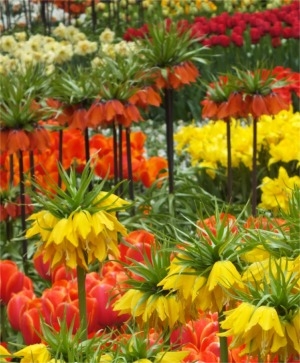 However, if you find a Fritillaria bulb with a discolored spot that is soft and you can push your finger into it, please call us. This rarely happens, but if it does, let us know and we will take care of it. That is not a good thing.
However, if you find a Fritillaria bulb with a discolored spot that is soft and you can push your finger into it, please call us. This rarely happens, but if it does, let us know and we will take care of it. That is not a good thing.
Many Fritillaria bulbs smell skunky. That is normal and a good thing since it helps repel rodents.
Bulb Size
Each Fritillaria variety makes its own special top size bulb. Some are as small as 5 centimeters, while others are 20 centimeters and up!
If you find that one bag of Fritillaria bulbs contains larger and smaller bulbs, it is a glass half full or half empty issue. Each of the bulbs is, at a minimum, the top size specified for that variety. They are sized on conveyor belts in the Netherlands that have holes the centimeter size just below the top size measurement. Smaller bulbs fall through these holes and are not included in our stock. All of the larger bulbs are included in our stock, and, as a result, there can be size variation. But it is definitely a glass half full! (If any variety in any season produces a smaller top size bulb than expected, we note it on our website. If a price change occurs as a result, we post the new price and make an adjustment on every order.)
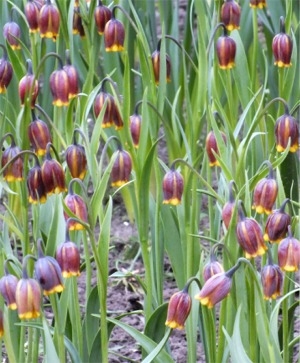 Bulb Storage Before Planting
Bulb Storage Before Planting
After you’ve received your order and inspected it, keep the exterior carton and the inner boxes open to give the bulbs some air. All bulbs love good air circulation. Store them in a cool, dry place with low humidity, away from heat, frost and strong sunlight at about 50°F to 70°F. Never put flower bulbs in the freezer! Poor storage conditions could cause bulbs to dry out, or to become moldy.
Again, Fritillaria bulbs really don’t like being out of the soil. It is best to plant them as soon as you can after receiving them.
Select and Prepare the Planting Site
All Fritillaria require rich, well-draining and neutral pH soil. The best soil is a sandy loam. For clay soil, break up the clay about a foot deeper than the planting depth of your bulbs and amend the bed with sand, peat moss and/or well-aged, neutral pH compost. For excessively sandy soil, amend the bed with peat moss, aged leaf compost and/or well-aged, neutral pH compost.
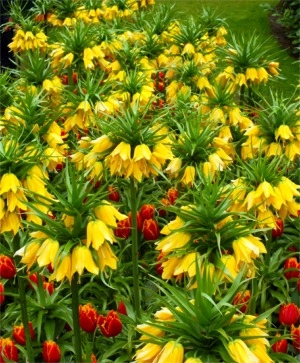 Please do not ever add horse manure, chicken droppings, mushroom compost, other hot manure or immature compost to your flower bulb beds. If you would like to add compost you’ve made yourself, please make sure that it is completely decomposed, healthy and neutral pH. Partially decomposed compost can spread fungal disease, such as botrytis blight, and nasty pests. What is good for vegetables is not necessarily good for flower bulbs.
Please do not ever add horse manure, chicken droppings, mushroom compost, other hot manure or immature compost to your flower bulb beds. If you would like to add compost you’ve made yourself, please make sure that it is completely decomposed, healthy and neutral pH. Partially decomposed compost can spread fungal disease, such as botrytis blight, and nasty pests. What is good for vegetables is not necessarily good for flower bulbs.
Fritillaria thrive in filtered to partial sunlight. Fritillaria meleagris prefers cooler soil with a bit of moisture in it.
Easy to Plant
Plant the large Fritillaria bulbs 6" to 7" deep and 8" to 10" apart. Plant the smaller Fritillaria bulbs 5" to 6" deep and 5" to 6" apart. They are easy to plant and are low maintenance. We'll ship you the bulbs in time for planting in your garden in the fall, once the ground has chilled down to about 55°F, after about two weeks of sweater weather when night time temperatures have hovered in the 40s. Again, it is best to plant Fritillaria bulbs as soon as you receive them because they don’t like being out of the soil. If they are planted too late, root system growth could be hampered. Immature, underdeveloped root systems could result in more foliage than flowers.
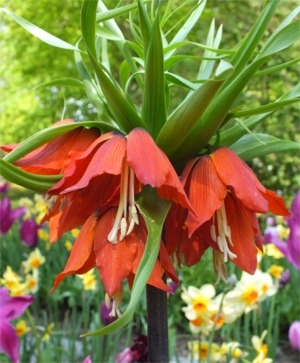 Please do not put anything in the bottom of hole that you’ve dug for the bulbs. Even if you think it is good for the bulb, it could cause root burn. Nestle the bulb into its hole, fill in the hole with soil to the level of the bed, and tamp down the soil lightly, making sure that individual holes are no longer apparent and that the garden bed surface is level. This will help to prevent water from filling up any of the individual planting holes. All flower bulbs hate to get wet feet.
Please do not put anything in the bottom of hole that you’ve dug for the bulbs. Even if you think it is good for the bulb, it could cause root burn. Nestle the bulb into its hole, fill in the hole with soil to the level of the bed, and tamp down the soil lightly, making sure that individual holes are no longer apparent and that the garden bed surface is level. This will help to prevent water from filling up any of the individual planting holes. All flower bulbs hate to get wet feet.
Fertilizing
Never put anything, including fertilizer, in the bottom of each bulb planting hole. To do so is to run the risk of root burn. Plant the bulbs to the proper depth and spacing, tamp down the soil and broadcast a 5-10-5 or 4-10-6 granular organic fertilizer over the surface of the bed as if you were feeding the birds.
While all flower bulbs are nature’s perfect little packages and will bloom beautifully the first year, we recommend broadcasting fertilizer three times a year for all perennial and naturalizing flower bulbs. First at the time of fall planting to help grow the roots, second when the sprouts emerge in the spring to help nourish the foliage and flower, and finally, when the flowers start to die back to help feed the bulb itself. Bone meal is incomplete nutritionally and can attract animals to some varieties of bulbs (like Crocus or Tulips).
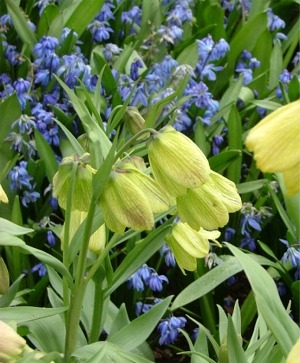 Do Not Plant Fritillaria in Exterior Containers or Raised Beds
Do Not Plant Fritillaria in Exterior Containers or Raised Beds
Flower bulbs should never be planted in outdoor containers, window boxes or raised beds where bulbs experience temperature spiking and repeated cycles of freezing and thawing. This results in root growth failure, root system destruction, frozen bulbs and/or bulb rot from poor water drainage. Flower bulbs must have a consistent cold winter temperature with good water drainage in order to produce a mature root system that will permit foliage growth and flower production in the spring.
Bloom Times, Size and Color
The bloom time listed for each variety is for horticultural zone 5 in normal spring conditions. The warmer the horticultural zone, the earlier flower bulbs will bloom. The colder the horticultural zone, the later flower bulbs will bloom in the spring.
Flower bulbs do everything in response to temperature, sunlight and site conditions. Bloom times, heights and colors are approximations affected by temperature and site conditions regardless of the calendar date. If it is a warm spring, bulbs will bloom earlier. If it is a cold spring, bulbs will bloom later. If it is a long cool spring, followed by rapid warming, you may find odd bedfellows: earlier blooming Galanthus flowering right along side later blooming Crocus, Species Tulips and Narcissi. Each spring can offer a different sort of garden surprise party.
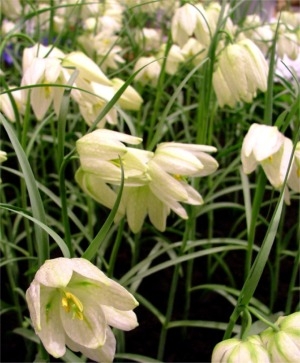 In the event of a mild winter or a warmer-than-usual spring, flower bulbs that have emergent stalks with set buds may bloom early, small and short, although they will likely grow taller and larger as temperatures moderate. Temperature spikes can also affect mature root development, the actual form of the flower or the process of flower color maturation.
In the event of a mild winter or a warmer-than-usual spring, flower bulbs that have emergent stalks with set buds may bloom early, small and short, although they will likely grow taller and larger as temperatures moderate. Temperature spikes can also affect mature root development, the actual form of the flower or the process of flower color maturation.
Spring Care
Once Fritillaria bloom and start to die back, make sure to keep the foliage going until it dies back naturally. A maximum period of photosynthesis allows the bulbs to regenerate for the future. Once the foliage is completely yellowed or browned out, remove it from the garden.
Don’t forget that Fritillaria are good cut flowers! The smaller, more diminutive varieties of Fritillaria acmopetala, meleagris, meleagris alba and uva-vulpis are wonderful in little vases tucked here and there. The larger varieties of Fritillaria persica, persica Green Dreams, persica Ivory Bells and raddeana are terrific in cut flower arrangements and taller vases.
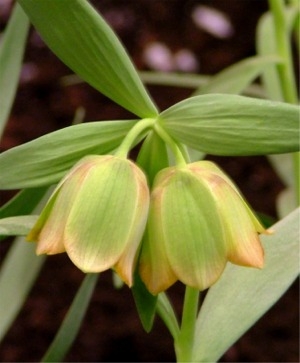 Forcing
Forcing
While most Fritillaria are not usually recommended for forcing over the winter, Fritillaria meleagris and meleagris alba are known to be good forcers.
In general, to force Fritillaria, one would pot the bulbs in mid-October and prechill them at a consistent, dark 38°F to 45°F with moderate watering for six to eight weeks. At the end of the precooling period, bring the pots out of refrigeration into progressively stronger sunlight with moderate watering. They usually bloom around four weeks later. Once Fritillaria bulbs are forced, their vitality is spent and the bulbs may be discarded.
Trouble Shooting
If Fritillaria are yielding more foliage than flowers, it normally indicates a root system issue. A mature planting may need to be dug up in the fall, and transplanted to the original depth and spacing after carefully separating the bulbs that may have been strangling themselves. Sometimes, the larger Fritillaria bulbs grow to the point that they split apart at the area where the woody stem has separated itself from the bulb. It can take years for each split-apart bulb to grow to the size whereby it would fully flower again. Please do keep the foliage growing and dying back naturally during this time. Again, Fritillaria are a bit more finicky than the average bulb. If they are planted in marginally hardy horticultural zones, they may complain by not staging return performances.




